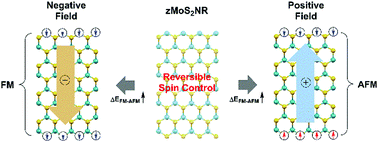当前位置:
X-MOL 学术
›
Phys. Chem. Chem. Phys.
›
论文详情
Our official English website, www.x-mol.net, welcomes your feedback! (Note: you will need to create a separate account there.)
Electric field effect on the magnetic properties of zigzag MoS2 nanoribbons with different edge passivation
Physical Chemistry Chemical Physics ( IF 3.3 ) Pub Date : 2017-11-01 00:00:00 , DOI: 10.1039/c7cp06161g Yeonsig Nam 1, 2, 3, 4 , Daeheum Cho 1, 2, 3, 4 , Jin Yong Lee 1, 2, 3, 4
Physical Chemistry Chemical Physics ( IF 3.3 ) Pub Date : 2017-11-01 00:00:00 , DOI: 10.1039/c7cp06161g Yeonsig Nam 1, 2, 3, 4 , Daeheum Cho 1, 2, 3, 4 , Jin Yong Lee 1, 2, 3, 4
Affiliation

|
Electrical control of magnetic exchange coupling interactions is central to designing magnetic materials. In this study, we performed density functional theory calculations to investigate the magnetic spin configuration, magnetic moment, and magnetic coupling strength of zigzag MoS2 nanoribbons (zMoS2NRs) with different edge passivation, that is, pristine (Pristine), hydrogen termination (H-tem), sulfur termination (S-term), and sulfhydryl termination (SH-term). Further, we investigated the influence of an external electric field (FExt) on the magnetic properties. Pristine and H-term showed an AFM ground configuration with considerably weak magnetic coupling strength while S-term and SH-term showed a single edge FM ground configuration in the absence of the electric field. When the external electric field was applied, the positive field intensified the original spin configuration, thus increasing the magnetic moment of the system while the negative field weakened the original spin configuration, thus decreasing the magnetic moment and further reversed the spin configuration from AFM to FM and vice versa in most systems. The magnetic coupling strength of the system increased for both Pristine and H-term regardless of the direction of the field. However, the extent of increase was much higher in Pristine due to the existence of relatively easily transferable dangling electrons compared with the constrained electrons of H-term restricted to chemical bonds. Our results demonstrate a possibility of reversible spin control from AFM to FM and vice versa by applying an electric field and the enhancement of the magnetic coupling strength of zMoS2NRs.
中文翻译:

电场对不同边缘钝化的之字形MoS 2纳米带磁性能的影响
磁交换耦合相互作用的电控制是设计磁性材料的关键。在这项研究中,我们进行了密度泛函理论计算,以研究具有不同边缘钝化的锯齿形MoS 2纳米带(zMoS 2 NR)的磁自旋构型,磁矩和磁耦合强度,即原始(原始),氢封端( H-tem),硫末端(S-term)和巯基末端(SH-term)。此外,我们研究了外部电场(F Ext)的磁性。原始和H项显示的AFM接地配置具有相当弱的磁耦合强度,而S项和SH项显示了在没有电场的情况下的单边FM接地配置。当施加外部电场时,正磁场会增强原始的自旋结构,从而增加系统的磁矩,而负磁场会使原始的自旋结构减弱,从而减小磁矩,并将自旋结构从AFM进一步反转为FM和反之亦然在大多数系统中。无论磁场方向如何,对于Pristine和H项,系统的磁耦合强度都会增加。然而,由于存在相对容易转移的悬空电子,而与限制于化学键的H项约束电子相比,Pristine的增加程度要高得多。我们的结果表明,通过施加电场和增强zMoS 2 NRs的磁耦合强度,可以实现从AFM到FM的可逆自旋控制,反之亦然。
更新日期:2017-11-22
中文翻译:

电场对不同边缘钝化的之字形MoS 2纳米带磁性能的影响
磁交换耦合相互作用的电控制是设计磁性材料的关键。在这项研究中,我们进行了密度泛函理论计算,以研究具有不同边缘钝化的锯齿形MoS 2纳米带(zMoS 2 NR)的磁自旋构型,磁矩和磁耦合强度,即原始(原始),氢封端( H-tem),硫末端(S-term)和巯基末端(SH-term)。此外,我们研究了外部电场(F Ext)的磁性。原始和H项显示的AFM接地配置具有相当弱的磁耦合强度,而S项和SH项显示了在没有电场的情况下的单边FM接地配置。当施加外部电场时,正磁场会增强原始的自旋结构,从而增加系统的磁矩,而负磁场会使原始的自旋结构减弱,从而减小磁矩,并将自旋结构从AFM进一步反转为FM和反之亦然在大多数系统中。无论磁场方向如何,对于Pristine和H项,系统的磁耦合强度都会增加。然而,由于存在相对容易转移的悬空电子,而与限制于化学键的H项约束电子相比,Pristine的增加程度要高得多。我们的结果表明,通过施加电场和增强zMoS 2 NRs的磁耦合强度,可以实现从AFM到FM的可逆自旋控制,反之亦然。


























 京公网安备 11010802027423号
京公网安备 11010802027423号